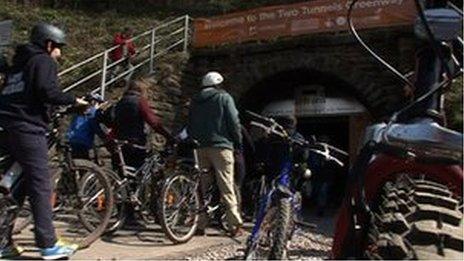Are Wales' disused railway tunnels an untapped resource for tourism?
- Published
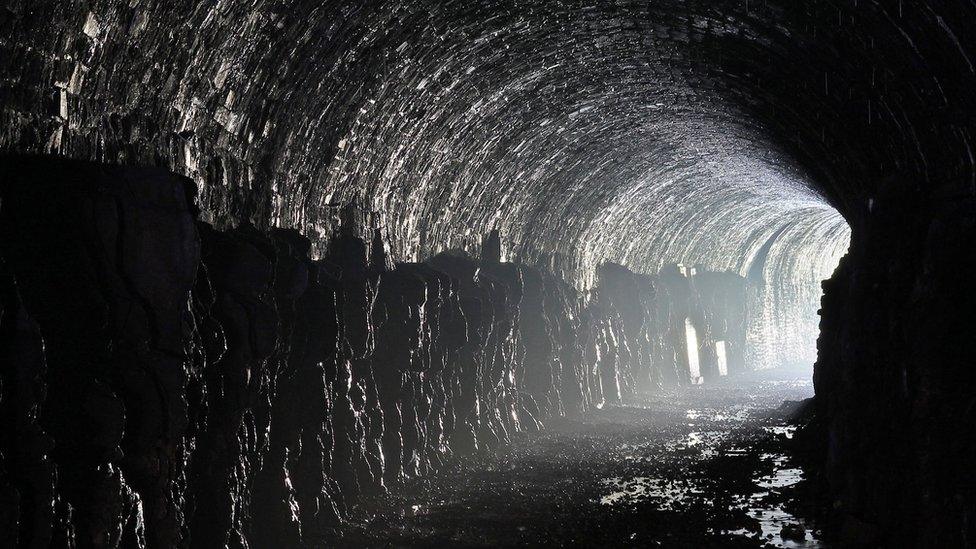
Is there light at the end for disused railway tunnels in Wales? The Torpantau tunnel was one of 21 considered by Sustrans
Disused railway tunnels lie dormant across the Welsh landscape, but there are some who want to breathe new life into them. Should these dark and dingy passageways be left sealed up or could they be an untapped resource for tourism and commuting?
One old train tunnel in particular has captured the public's imagination in the last couple of years.
If reopened, the Rhondda tunnel, external - which is more than 3km (two miles) long - would be the second longest walking and cycling tunnel in the world.
And the Rhondda Tunnel Society, which has been set up in a bid to make the project a reality, has received widespread support, including from Hollywood actor Michael Sheen.
Gwyn Smith, from cycling charity Sustrans, external, described it as the "sexy" scheme, and said "it would be nice to bottle that enthusiasm for some of the other projects".
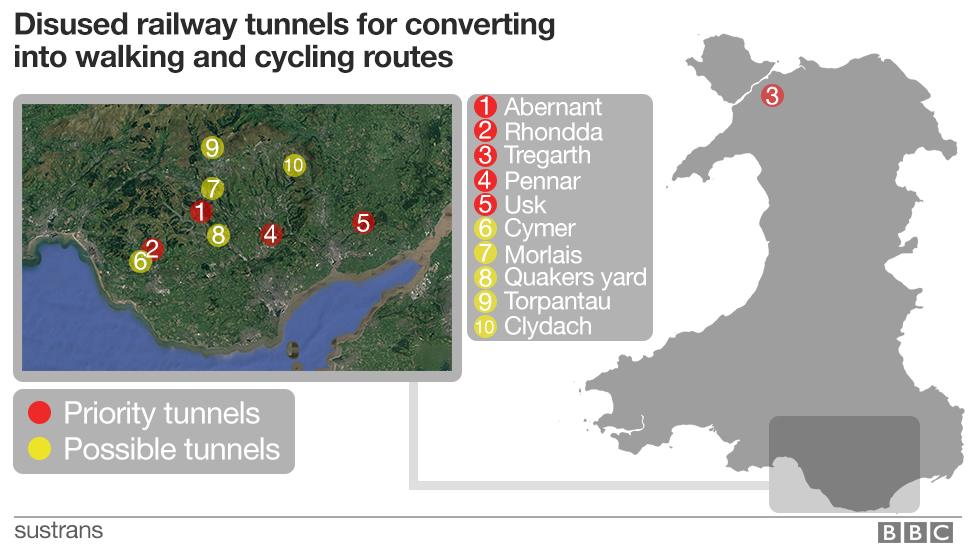
Sustrans has highlighted five tunnels to be looked at as a priority and five others which are possibilities
Last year he looked at 21 former railway tunnels, external in Wales to assess their potential as walking and cycling routes, at the request of the Welsh Government.
He shortlisted five as a priority - Abernant, Rhondda, Tregarth, Pennar and Usk - and earmarked a further five "possibles".
A year on, one of them - the Tregarth tunnel, in Gwynedd - looks set to be ready for use by next spring.
This could be used as a "pilot", Mr Smith said, before tackling the other, longer tunnels in south east Wales.
Tregarth would be the first major railway tunnel in Wales to be reopened.
But across the Severn Bridge, the Two Tunnels Greenway in Bath has already been a success. At more than a mile long, the Combe Down tunnel is currently the longest cycling tunnel in Britain.
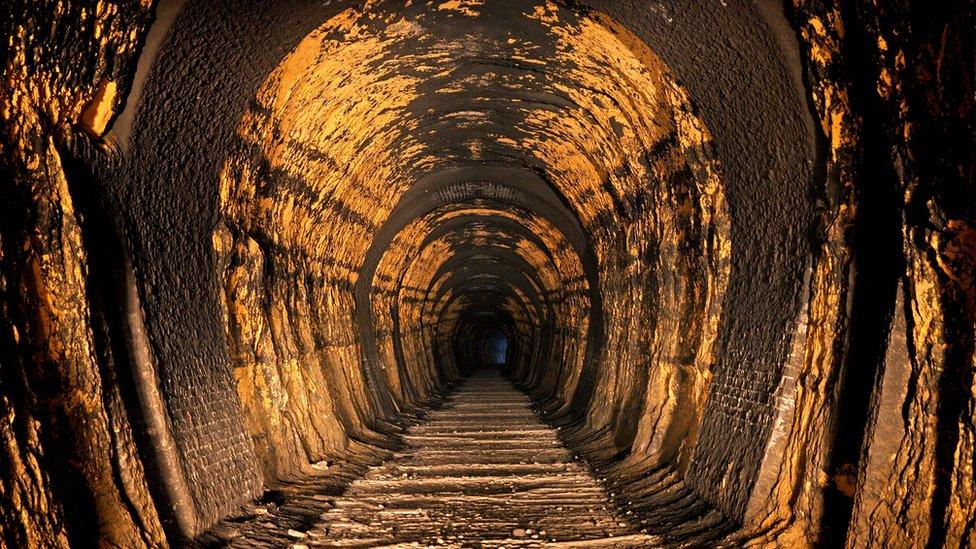
Combe Down tunnel - part of the Two Tunnels Greenway - before works
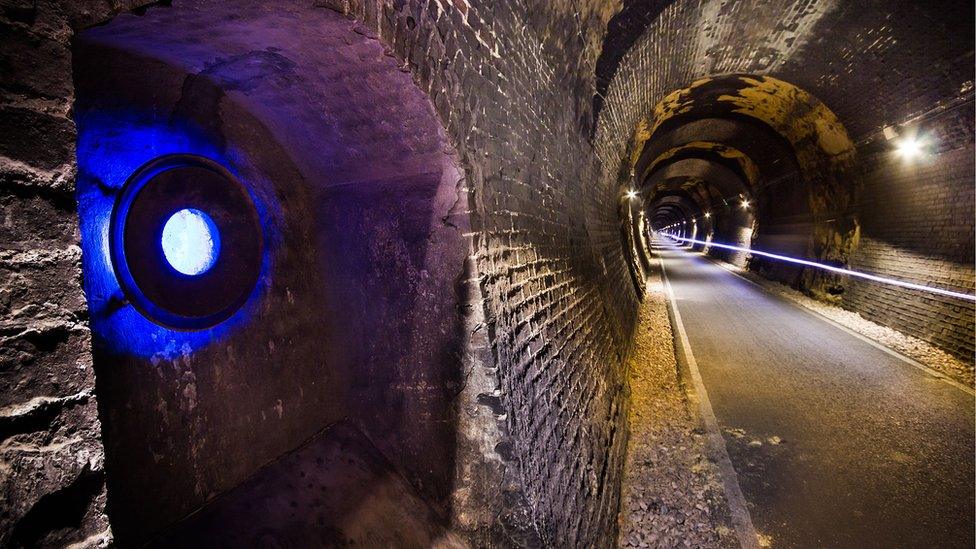
Combe Down tunnel after works
Mr Smith likened the Two Tunnels project to "a steeplechase through a minefield" before construction work began and said the Rhondda tunnel was similar in many ways.
He held the project up as an example of the difficulties faced in opening disused tunnels, but also the tourism it can attract.
"Both the Rhondda and Abernant tunnels could also be expected to have considerable impact as a tourist attraction," he said.
Frank Thompson, chairman of the community-based Two Tunnels Group, said their first meeting was in a pub in February 2005.
"The Two Tunnels Greenway opened on 2 April 2013, so it was eight years from flash to bang," he said.
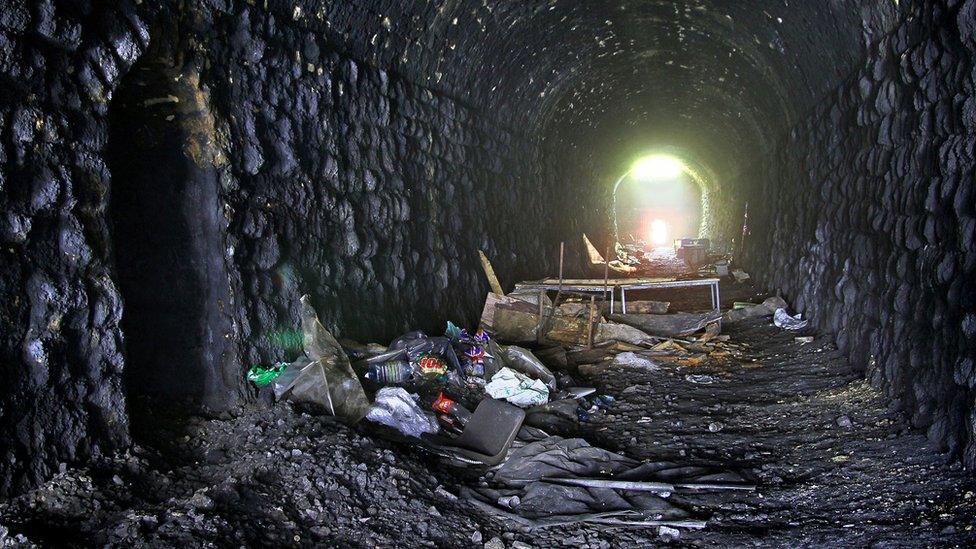
Devonshire tunnel - part of the Two Tunnels Greenway - before works
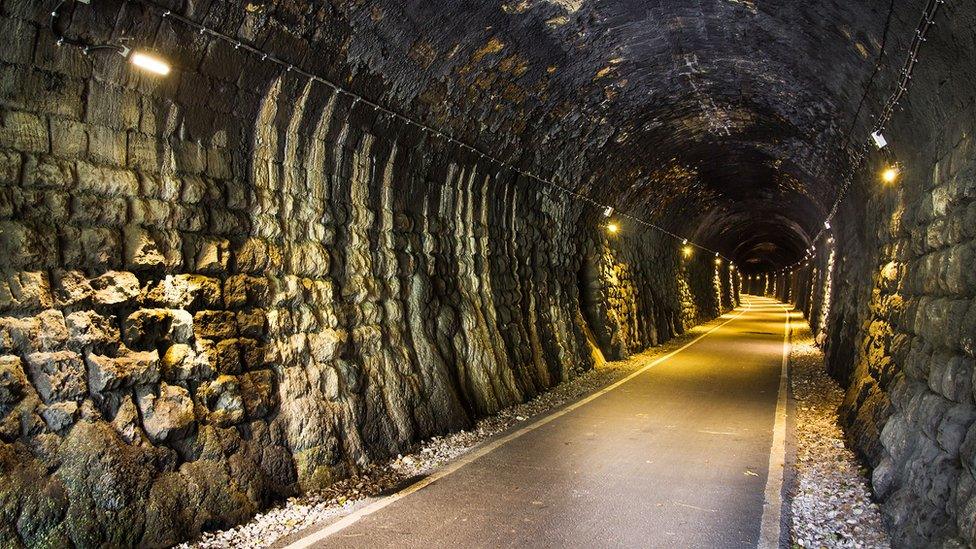
Devonshire tunnel after works
Mr Thompson said difficulties they faced included opposition from those who thought it would encourage muggings, vandalism and people sleeping in the tunnels.
He said this meant gates and a CCTV system had to be installed "at huge expense".
There were also "unforeseen and expensive infrastructure requirements", issues over land and infrastructure ownership, a planning application which took more than a year, bat surveys and the relocation of 50 adders.
The overall cost of opening was £4.2m for four miles of shared-use path, built by Sustrans with cash from the Big Lottery Fund.
But Mr Thompson said it had been "hugely successful", attracting visitors from all over the UK, Europe and beyond. A census after the first year of operation revealed more than 250,000 users.
"No two projects are the same and the Welsh projects will face their own challenges, including raising capital and recent and ongoing lack of support from local and central government," he said.
"The Two Tunnels Group wishes each project huge success. Perseverance is a key ingredient."

Cyclists at the opening of the 1,672m-long Combe Down tunnel
Graeme Bickerdike, editor of the Forgotten Relics, external website, said: "Two issues that all such schemes face now are the culture of risk aversion that pervades most public bodies and, obviously, the adverse economic climate."
Mr Bickerdike, who is providing engineering support to a group hoping to reopen Queensbury tunnel in West Yorkshire, said: "The Two Tunnels' campaign was fortunate in benefitting from the large pot of money available to Sustrans through the Connect2 lottery windfall and the fact that Combe Down tunnel was in excellent condition.
"Both the Queensbury and Rhondda tunnel proposals have come about 10 years too late and unfortunately the same will probably be true for any of the other Welsh tunnels where there are issues relating to their condition.
"That's not to say they are hopeless cases; only that the hill to climb will be very much steeper.
"Whilst many recognise their potential in terms of tourism, health etc, there is a clear - and sometimes understandable - resistance to take on such structures at 'official' level within statutory bodies."
Mr Smith agreed opening up the Welsh tunnels was a "long game".

The portal to the Rhondda tunnel
"It would be nice to say 'you would be able to open up the Rhondda tunnel or Abernant tunnel for X amount of money'," he said.
"But with longer tunnels, unless you spend quite a lot of money doing engineering surveys, that final cost is unknown. You need to do so much work and then look at the benefit-cost ratio and you may find it's not worth doing.
"The hardest part is not the construction it's all the stuff that goes on beforehand.
"If you can have a project what we call 'shovel ready', there are more funding opportunities."
He said the shorter tunnels should be easier to open as there was not the fear that "people could jump out at me" as you can see from one end to the other.
The 2013 Active Travel Act says councils in Wales have to provide routes and consider cyclists and walkers when planning new road and rail links.
Mr Smith said he hoped the tunnels would be considered by councils when they do this.
Abernant tunnel
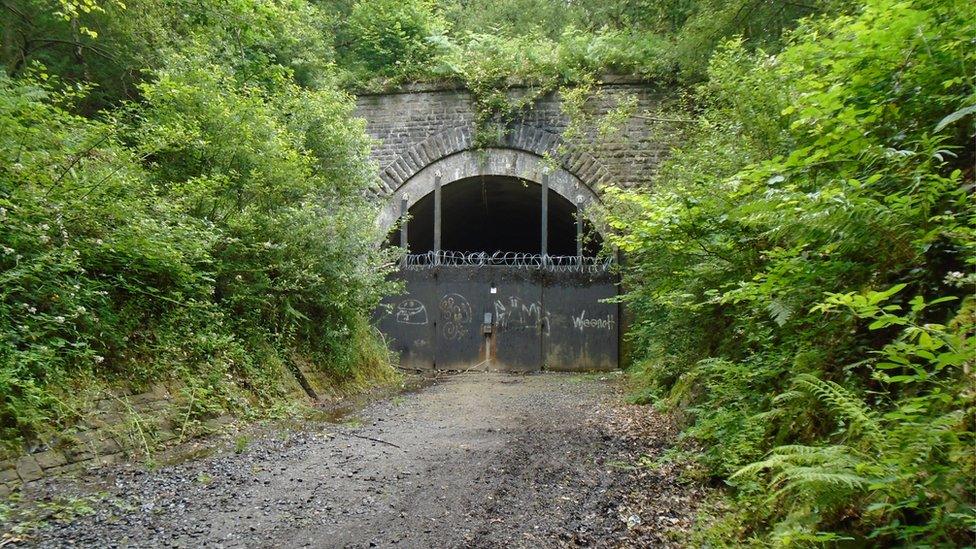
Length: 2,283m
Location: Between Merthyr Tydfil and Aberdare
Gwyn Smith said Abernant, as the second longest tunnel on the list, had high potential as a direct traffic-free route between Merthyr and Aberdare, that was close to Bike Park Wales and could be linked to the Taff Trail.
"The attractiveness of the Abernant tunnel is it has a much higher potential than the others for changing the way people travel," Mr Smith said.
"We looked at census data and we can tell people living in Aberdare and Merthyr Tydfil travel a lot between the two valleys."
He added: "When we were talking about it eight or 10 years ago, everyone thought we were mad. As time has gone on, more and more people are interested and it seems more likely to happen."
He said the councils at either end - Merthyr Tydfil and Rhondda Cynon Taf - were interested, but there was a "conflict of interest" for the latter because the Rhondda tunnel was high profile and Abernant tunnel was "sleeping".
A Merthyr council spokeswoman said they were exploring the possibility of opening the tunnel as part of developing the town as a visitor destination, and also connection to the wider trail network.
She said: "Discussions are ongoing with the landowners and key strategic partners, including Sustrans, and further feasibility development we are hoping will continue in 2017."
Rhondda Cynon Taf council has been asked to comment.
Tregarth tunnel
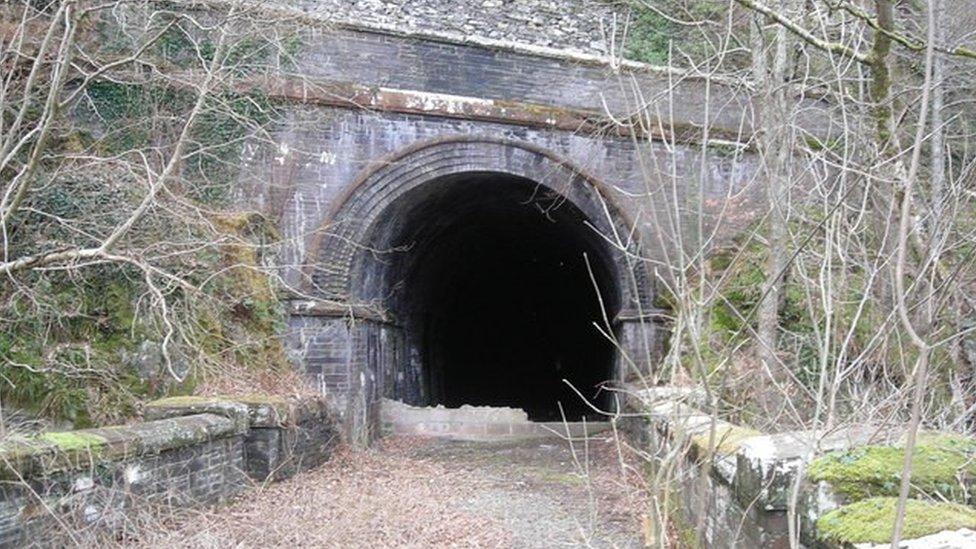
Length: 275m
Location: Bethesda
Gwynedd council's cabinet approved a recommendation to extend part of the Lon Las Ogwen path through the tunnel in June this year.
A council spokesman said the scheme, which will be funded by the local authority and through the Welsh Government's Local Transport Fund, would get under way early in the new year and it is expected work will be completed by April 2017.
The tunnel is already "shovel ready" and will be a "level and direct alternative to a steep climb and a road".
Gwyn Smith said: "There are reasonably good cost estimates of work to open it up and we could use it for cost estimates on shorter tunnels.
"What they learn and, perhaps, how it's run over the next couple of years will have a real impact on other bigger tunnels."
Rhondda tunnel
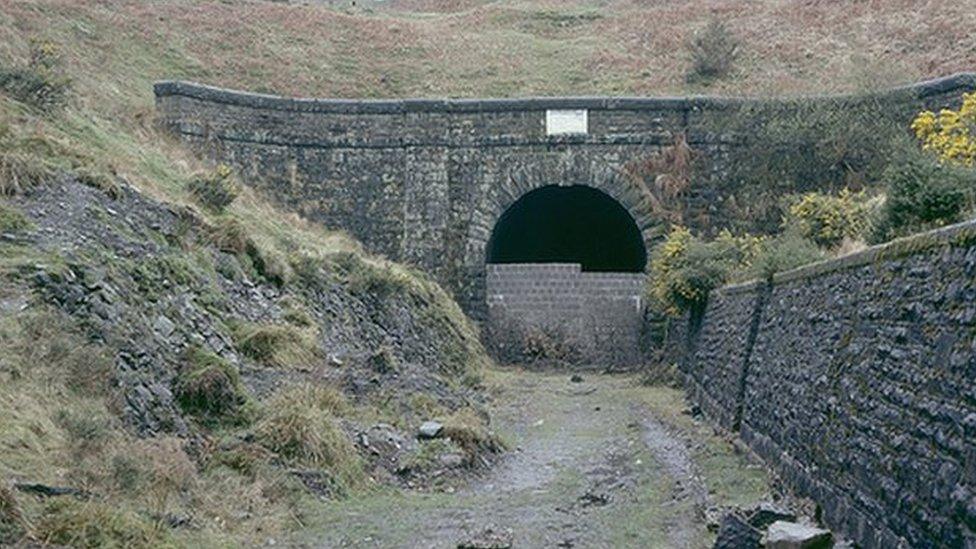
Length: 3,148m
Location: Between the Rhondda and Afan valleys
The Rhondda Tunnel Society was set up by Steve Mackey two years ago in a bid to push this project forward.
Mr Mackey said: "I used to play in the tunnel. I'd walk half way in, about a mile, with a candle in a tin, and sit there and marvel at the brick work, mesmerised."
But the tunnel was filled in and he said: "When I was 10 I was hanging from a rope over the mouth of the tunnel, with a paint pot in my hand, painting the commemorative stone with the words 'please open me'."
He said being chairman of the society had now turned into a full-time - unpaid - job.
The tunnel, he said, could not get any major funding until ownership is transferred to Wales from Highways England.
But the Welsh Government has said it was their understanding ownership was not required to take next steps.
Gwyn Smith said the project had "tremendous appeal as a tourist destination".
"What's nice about the Rhondda tunnel is the way the community has got behind it," he said.
"Without really good community support it's perceived there will be vandalism and bad behaviour, but with Rhondda both sides have got so involved in it I can't see that being much of a problem."
Usk tunnel
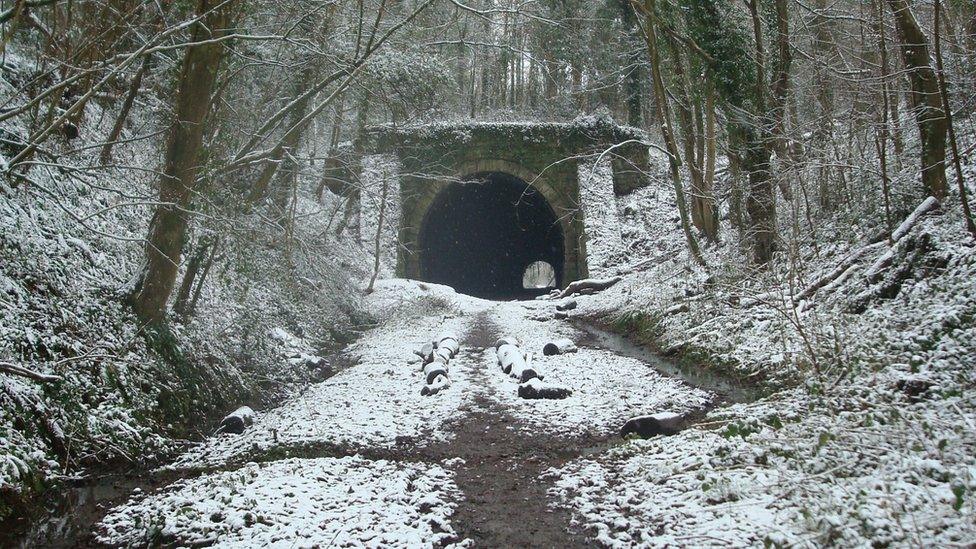
Length: 234m
Location: Usk
Mr Smith said this route avoided the busy A472 through the town and gave direct access to Usk Primary School.
He said there was local support to develop it as many people already walk through it.
But he said it could be an expensive project because there were newts and bats there.
A Monmouthshire council spokesman said while there were no specific plans to use it, the local authority was developing Integrated Network Maps - future walking and cycling networks - for Usk and six other towns.
He said: "For the draft plans we are looking at all sorts of existing info, including Sustrans studies. It is quite possible that they may contain a route making use of the tunnel, but this is by no means certain.
"Incidentally, both the Local Development Plan and the Local Transport Plan contain proposals for an Usk traffic relief scheme/by-pass. A number of alignments have been looked at, including using the tunnel."
Pennar tunnel
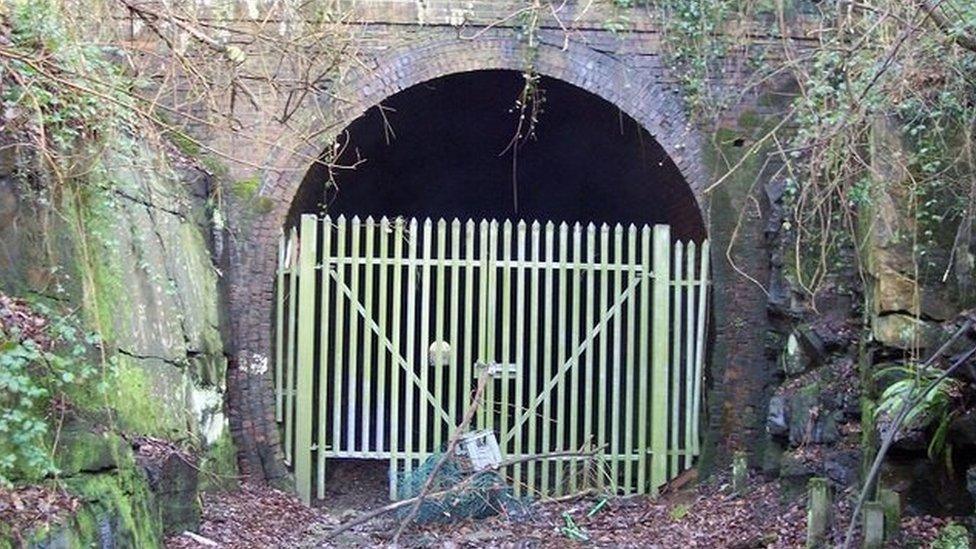
Length: 364m
Location: Between Pontllanfraith and Newbridge
Mr Smith said opening this tunnel would provide a cross-valley route for commuting that would avoid a busy road.
He said it would be "relatively easy" to return to use and had attracted "an overwhelmingly positive response" from local people.
A Caerphilly council spokeswoman said they were currently developing the county borough's Integrated Network Map.
She said: "While we are not actively progressing the reopening of the tunnel we will be developing the cycle network in the Newbridge area for utility journeys.
"This is led by working with the local members and communities and must consider what routes will be used for everyday journeys.
"We will be consulting with stakeholders and the public on the draft Integrated Network Map next year."
- Published17 November 2016

- Published19 February 2016
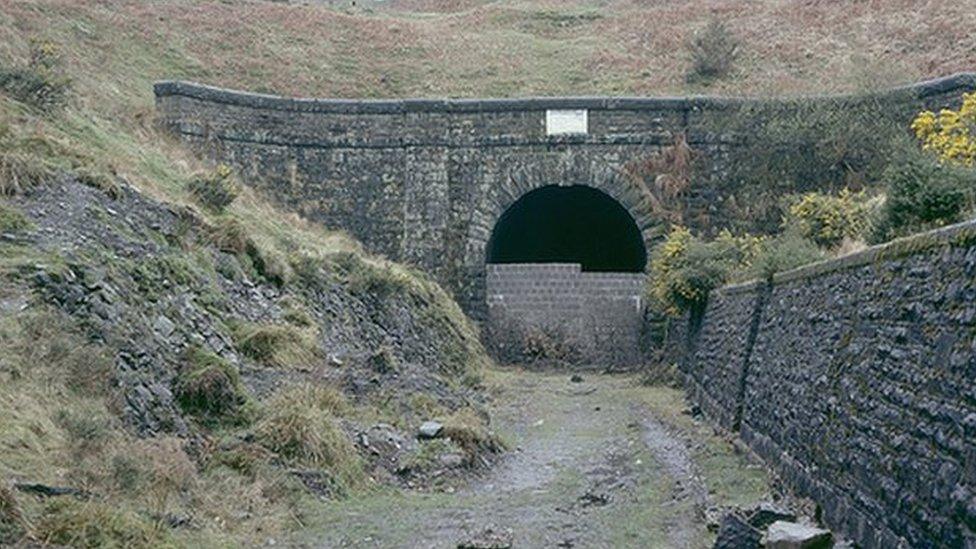
- Published20 January 2016

- Published11 May 2015
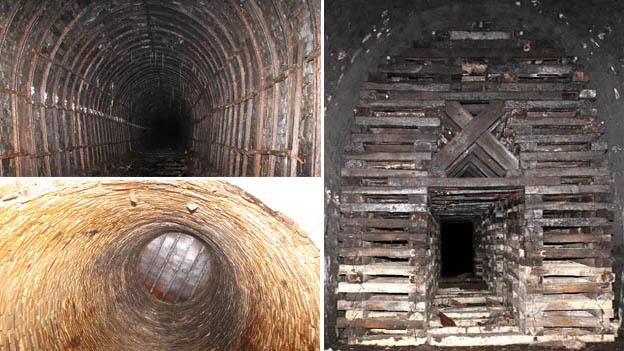
- Published3 May 2015
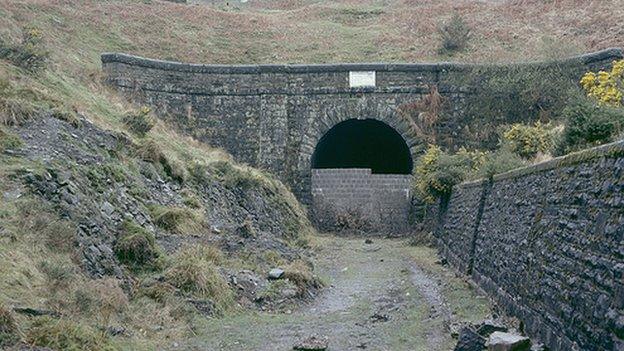
- Published3 December 2014

- Published6 April 2013
